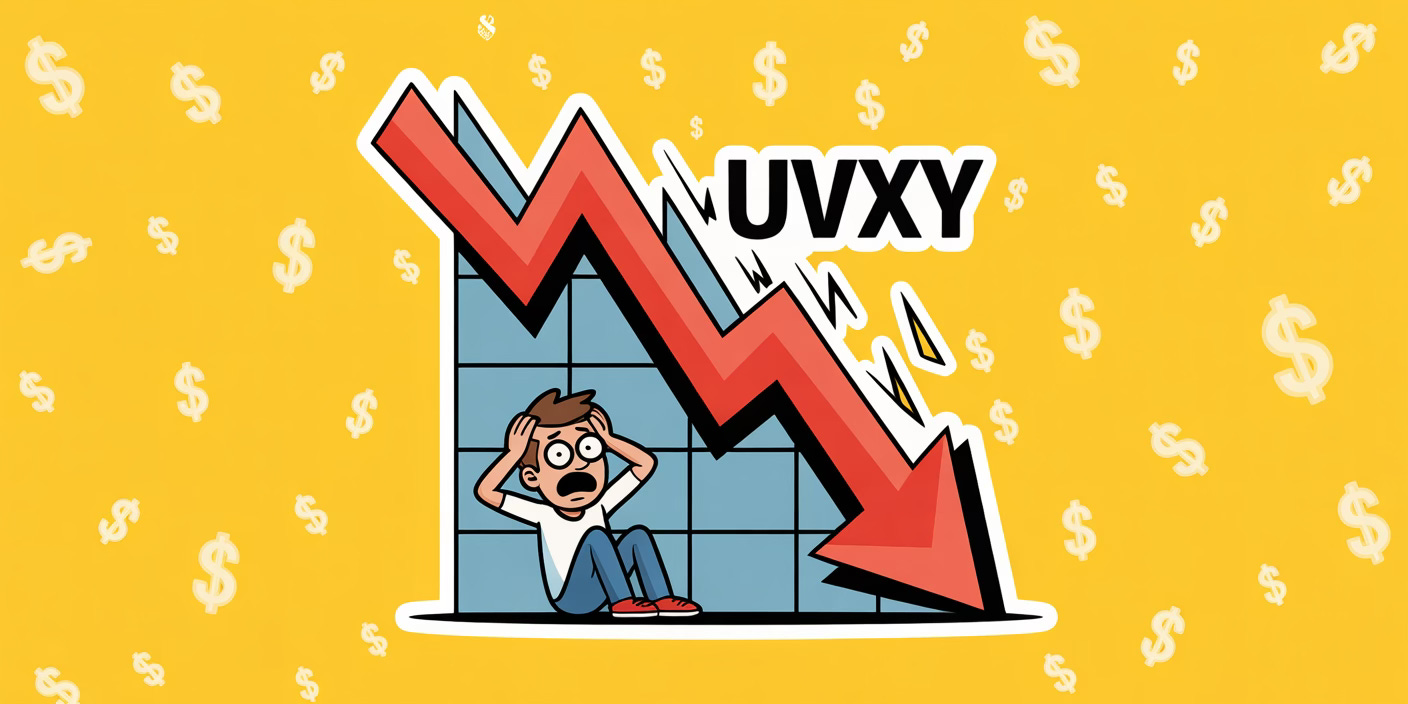Among the most traded volatility products on the market is UVXY, the leveraged VIX ETF. To the untrained eye, UVXY looks like a simple way to profit when fear rises — but much like its 2x cousin UVIX, UVXY is a product that steadily decays over time.
This article explains what UVXY is, why it trends lower in the long run, why it should not be held as an investment, which types of traders might use it, and who should avoid it entirely.
What Is UVXY?
UVXY is an exchange-traded fund that provides 1.5x daily exposure to a rolling position in short-term VIX futures (the front two monthly contracts).
It does not track the spot VIX directly, because the VIX is not tradable. Instead, it amplifies moves in VIX futures.
Unlike UVIX (2x), UVXY is 1.5x leveraged, but it suffers from the same structural issues of roll costs and compounding decay.
In short: UVXY is a leveraged futures-based volatility product, not a pure “VIX tracker.”
Why Does UVXY Go Down Over Time?
A glance at UVXY’s long-term chart tells the story: near-constant decline punctuated by sharp spikes during crises. This happens for two reasons:
Contango Drag
Most of the time, VIX futures are in contango (longer-dated contracts are more expensive than near-term).
Because UVXY rolls contracts forward daily, it continuously sells cheaper contracts and buys more expensive ones.
This creates a systematic drag that erodes value.
Leverage and Compounding Decay
UVXY delivers 1.5x daily returns of its VIX futures index.
Over time, daily compounding in choppy markets causes beta slippage, where UVXY underperforms what investors expect.
Even if the VIX ends up unchanged, UVXY tends to lose value.
Together, these forces ensure that UVXY trends lower over months and years, only spiking higher when volatility surges dramatically.
Why UVXY Is Not a Buy-and-Hold Entity
UVXY is mathematically structured to decline over time.
Long-term investors will almost certainly lose money, even if volatility spikes occasionally.
It is better thought of as a short-term tactical instrument for volatility events, not as a portfolio holding.
Who Should Use UVXY?
Short-Term Speculators
Traders betting on a near-term volatility spike (e.g., before earnings, CPI releases, Fed meetings, or geopolitical risks).
Typical holding periods: hours to days.
Event-Driven Hedgers
Investors who want quick, leveraged exposure to volatility during risk events.
Useful as a hedge, but only if managed with strict timing.
Options Traders
Some advanced traders use UVXY options for hedging or volatility strategies, taking advantage of its high implied volatilities.
Who Should Avoid UVXY?
Long-Term Investors
Anyone holding UVXY for weeks or months is almost guaranteed to face decay.
Beginner Traders
Without an understanding of contango and decay mechanics, beginners often lose money by holding UVXY too long.
Income or Passive Investors
UVXY pays no dividends and carries extreme volatility. It is the opposite of a steady wealth-building tool.
Historical Context
UVXY’s history is littered with reverse splits, which reset its share price after repeated declines. Like UVIX, VXX, and TVIX before it, UVXY’s chart tells the same story: a steady grind lower, interrupted only by occasional crisis-driven spikes.
Practical Applications for Traders
Event Trading
Buy UVXY ahead of major risk events if you expect a volatility surge. Exit quickly once the event passes.
Short-Term Hedging
A small UVXY position can offset losses in equities during market stress — but timing is everything.
Avoid Holding During Calm Periods
In quiet markets, UVXY’s decay is relentless. Some sophisticated traders even short UVXY during prolonged calm, though this carries substantial tail risk.
Key Takeaways
UVXY provides 1.5x daily exposure to short-term VIX futures.
It decays over time due to contango drag and compounding decay.
It is a short-term trading tool, not a buy-and-hold investment.
Best for: short-term speculators, tactical hedgers, options traders.
Worst for: long-term investors, beginners, passive strategies.
Final Thoughts
UVXY is one of the most popular volatility ETFs, but also one of the most misunderstood. Its design ensures that it trends lower over time, making it a poor choice for long-term investors. For active traders with precise timing, however, it can be a powerful instrument during volatility spikes.
The bottom line: UVXY is for trading, not investing. Handle it with caution, discipline, and a clear exit strategy.


